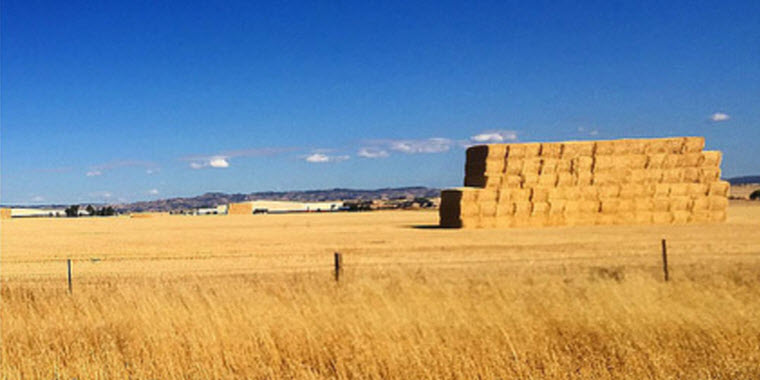By Janna Kincheloe, SDSU iGrow
Optimal growing conditions across much of South Dakota this summer have resulted in large quantities of forage being produced. However, quality can vary greatly among and even within fields. Conducting a nutritional laboratory analysis on hay and/or silage samples is the best way for producers to evaluate the nutrient content of their feedstuffs. This information, in combination with the nutrient requirements of the animals being fed, is a cost-effective way to determine economical and practical winter feeding programs.
The Importance of Sampling
Proper sampling is important to ensure the most accurate results. The first step in proper forage analysis is identifying a single ‘lot’ of hay or silage. According to the National Forage Testing Association, a lot is defined as a single cutting, field, and variety, and will generally be less than 200 tons. Combining samples across various lots will not provide an adequate representation of forage quality.
When sampling hay, producers should walk around the stack and sample bales at random using a hay probe. On round bales, the probe should be inserted from the wrapped side into the center. On square bales, insert the probe from the end to the center. Collect at least twenty (20) core samples per lot, package in a clean plastic bag, and store in a cool, dry place before mailing it to a lab.
It is preferable to sample silage before ensiling rather than as it is being fed so that quality can help guide management decisions. However, samples can also be collected after ensiling. Taking grab samples from the face of a silage pit is not recommended due to high variability in nutrient content and safety concerns. Instead, scrape across the face using a loader bucket, and collect grab samples off the pile on the ground. If feeding a total mixed ration (TMR), grab samples can also be collected as dispensed from the feed mixer. If sampling from a silo bag, grab samples can be collected from different locations across the silage face over several days, or core samples can be collected through the sides of the tube at various locations along the length. Mix samples thoroughly in a bucket and place approximately 1 pound of sample in a clean plastic bag for analysis. Samples should be stored in a freezer until shipping.
Quality Analysis
A typical forage quality analysis costs between $12 and $40 and will include dry matter, crude protein, estimation of total digestible nutrients (TDN), and fiber content. Dry matter is the percentage of forage that is not water (DM, {28d451f77a4de8a52cd2586be6cc1800527fe70ea84e8b3f90098495d088e086} = 100 – {28d451f77a4de8a52cd2586be6cc1800527fe70ea84e8b3f90098495d088e086} moisture). Knowing dry matter content is important in ration formulation since nutrient requirements of animals are expressed on a DM basis. It becomes most important when comparing dry feeds such as hay to wet feeds such as silage. It can also be valuable for determining when forage may have been put up too wet, which can reduce protein availability to the animal and/or lead to mold issues. Crude protein (CP) represents both protein and non-protein nitrogen in the hay, and is used to determine the ability of a certain forage to meet an animal’s protein requirements. Acid detergent fiber (ADF) includes cellulose and lignin content, which is the least digestible portion of a forage. A lower ADF value is more desirable since it indicates higher digestibility. Neutral detergent fiber (NDF) includes the ADF component in addition to hemicellulose. In general, NDF values are negatively correlated to the amount of forage that an animal can physically consume due to cell wall content. Total digestible nutrients (TDN) is commonly used to indicate the energy value of forage. Since there is no direct laboratory measure of energy availability, TDN values are calculated primarily from fiber and protein fractions in the forage. Producers may also choose to have forage analyzed for macro minerals such as calcium and phosphorus and trace minerals such as zinc and copper.
Testing Methods
There are two primary methods of testing forages available: wet chemistry or NIRS (Near Infrared Reflectance Spectroscopy). Wet chemistry utilizes chemical and heat processes to isolate and quantify nutrients, while NIRS results are based on the light spectrum reflected off a sample using a spectrophotometer. This process utilizes a calibration set based off similar types of samples that have been analyzed through wet chemistry. While wet chemistry is still considered to be the most accurate method for analyzing nutrient content, NIRS predictions are fairly accurate for common feedstuffs such as grass or alfalfa hay, provided that the sample was grown in the same region under similar conditions as the calibration samples. However, it is usually not as accurate for silages and less common annual forages such as millets. In general, NIRS analysis may be less expensive and have a shorter turnaround time than wet chemistry. It is important to keep in mind that NIRS is not considered accurate for mineral content and wet chemistry should be performed if minerals are of concern. Most labs offer wet chemistry, NIRS, or a mixture of both. A list of laboratories that offer feed testing services is available on iGrow.
More Information
Forage quality is one of the primary factors that will determine the amount of hay and supplement needed this winter. For more information about estimating forage usage and determining feed inventories, refer to the iGrow article Feedstuff Inventory: Quality and Quantity. For additional assistance in recommendations for forage testing and interpreting forage quality analysis, please contact your SDSU Extension Regional Center.
Source: SDSU iGrow
Reposted by Jami Howell with permission


